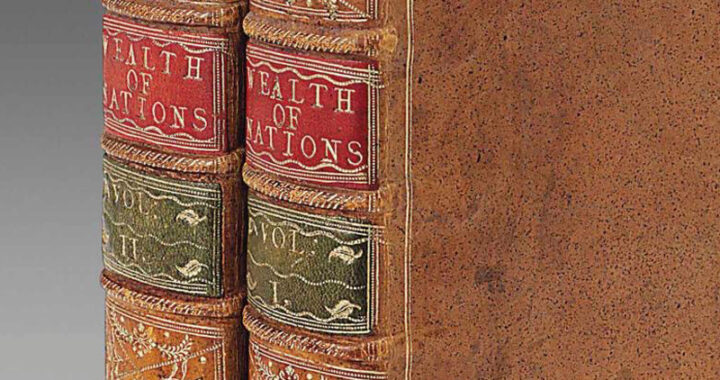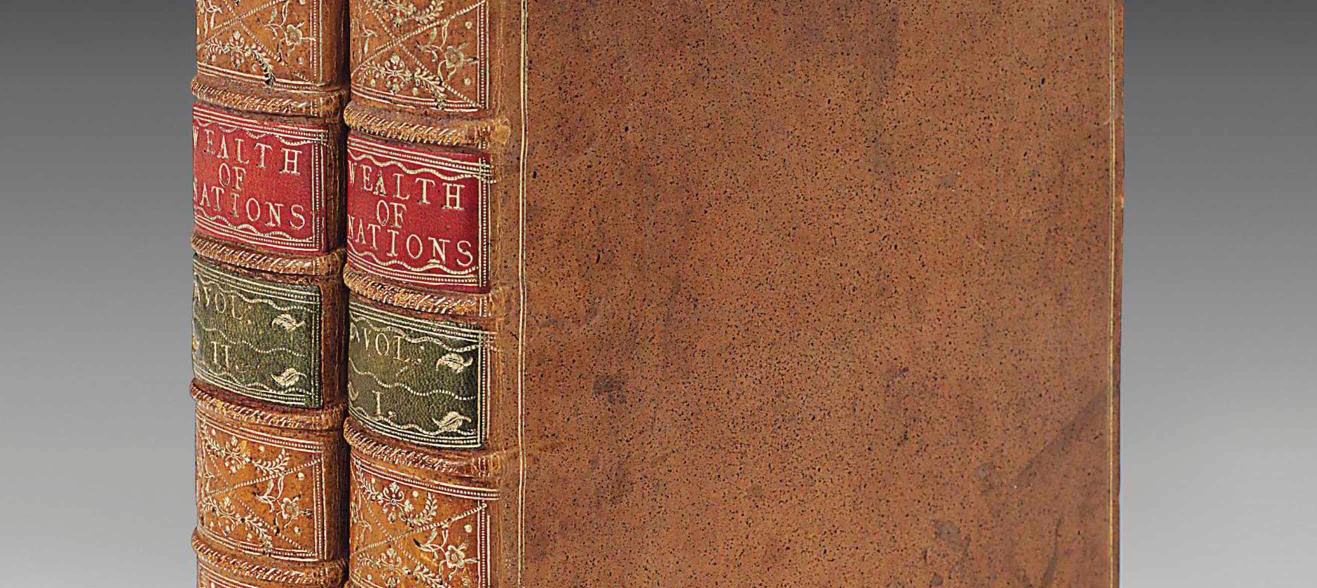
Copy of the Wealth of Nations from the library of Charles William Vane, 3rd Marquess of Londonderry
Download this article
Rupert Neelands, Antiquarian Book and Manuscript Specialist
Smith’s Wealth of Nations was an extended argument about how European countries, and Britain particularly, could achieve greater social and political stability by increasing their economic wealth. Having his profile on the back of the £20 note, issued from March 2007 to February 2020, would have been a more powerful reminder of his great treatise, had the note not changed hands so swiftly in millions of transactions. However, every transaction made with it was a demonstration of what Smith saw as the universal human propensity, “to truck, barter and exchange one thing for another”.
To his contemporaries Smith was a moral philosopher. He never courted celebrity but neither did he shun society. He clearly wanted to be remembered by what he wrote, and so actually cared little about his own portrait. There is no frontispiece portrait in either of his major works, and no known oil portrait from the life. The glass paste medallion by James Tassie, executed in 1787, “is the only satisfactory likeness of Smith and was conceivably modelled from the life” (NPG).
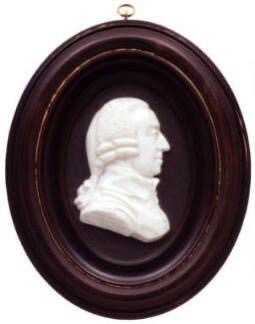
Adam Smith in his 64th Year, by James Tassie, 1787, glass paste medallion, National Portrait Gallery
Smith’s life ran a smooth course apart from the loss of his father, also Adam Smith. An advocate, private secretary to the third earl of Loudon and comptroller of customs at Kirkcaldy, Smith senior died five months before his son was born. Adam Smith junior was baptised on 5 June 1723. He had a caring mother in Margaret, the daughter of Robert Douglas of Strathendry, who brought him up in the fishing village of Kirkcaldy (population 1500) near Edinburgh. Being carried off by gypsies at the age of four was the only alarming experience of his childhood — if it indeed happened.
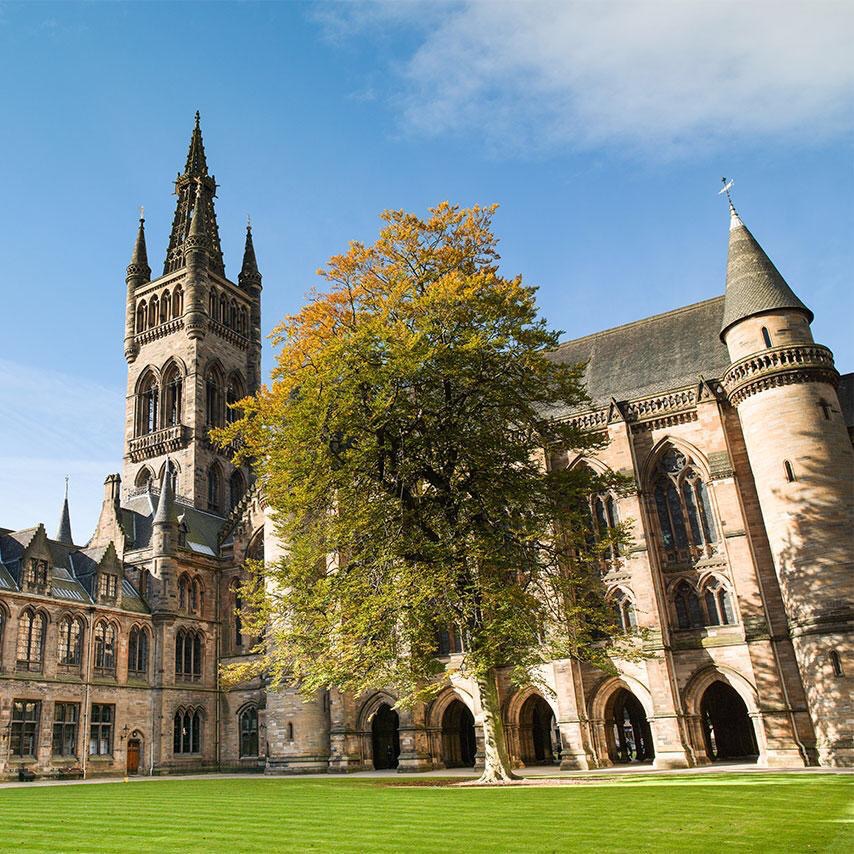
Glasgow University founded in 1451
At 14, Smith entered Glasgow University where the professor of moral philosophy, “the never to be forgotten” Francis Hutcheson, had a profound influence. Hutcheson emphasised the importance of the division of labour, and made a careful distinction between money as a medium of exchange and money as a standard of value. After graduating in 1740, Smith won a Snell exhibition to Balliol College, Oxford. Despite finding the intellectual atmosphere of Oxford far less vibrant than Glasgow — the exploded system of Aristotle was still taught, he nevertheless tolerated it for six years, and did so much private reading in political history and polite literature that he became physically exhausted. He had a retentive memory and wrote in a plain style with Swift and Addison among his models.
After Oxford, Smith returned to the seclusion of Kirkcaldy for two years. Then in 1748 he began delivering public lectures at Edinburgh University, sponsored by the Philosophical Society of Edinburgh whose patron was Lord Kames. The initial subjects were rhetoric and belles-lettres. Smith’s abiding friendship with David Hume, who was 12 years older, began in 1750, and only ended with the latter’s death on 25 August 1776. Hume’s Political Discourses (1752) was a work from which he developed many strands of argument; it contained the key notion that the pre-requisite of a thriving commerce is civil liberty.
Smith’s prominence in the intellectual mêlée of the Scottish enlightenment continued to grow. In 1751, at the age of 27, he was appointed professor of logic at Glasgow. A year later he changed chairs, becoming professor of moral philosophy for a period lasting until 1764. He taught a curriculum on ethics and the rights of man inherited from Hutcheson; and following a precedent set by his former teacher, his lectures were in English rather than Latin. His first published work was an article on Johnson’s Dictionary for the first Edinburgh Review in 1755.
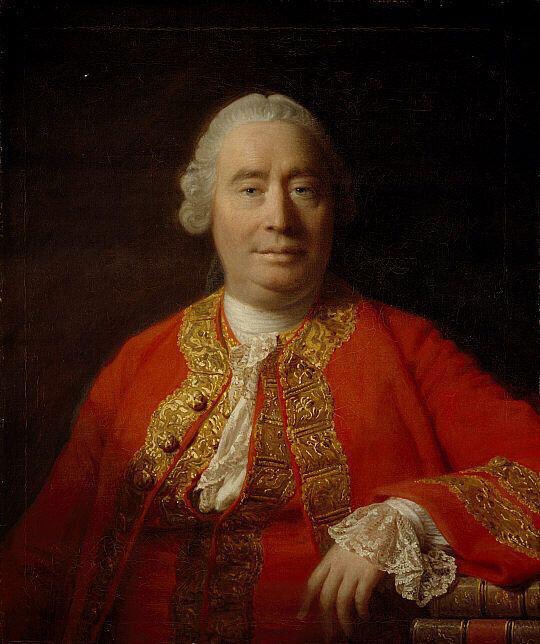
David Hume by Allan Ramsay, 1766, at the Scottish National Portrait Gallery
After lecturing by day Smith would join in Glasgow society by night, mingling with the city’s merchants and its learned men — despite good social relations, the support of the merchant class for monopolistic companies was to be castigated in Wealth of Nations. Smith neither married nor possessed a female confidante, excepting his mother, for any length of time. His treatise does make unexpected reference to the beauty of London’s Irish prostitutes, the product — he thought — of their diet of potatoes (I.xi).
Andrew Millar published the Theory of Moral Sentiments, based on his lectures in ethics, as a single octavo volume in 1759. The ambiguities in human nature were admitted from the opening sentence. While conceding that amoral self-interest is an abiding motive in human behaviour, Smith argued for the existence of an “inner man” or “impartial spectator” who is nevertheless able to judge the morality of an action. Moral sentiments arise from that mutual sympathy between individuals which alone creates a happy society. In both this work and the Wealth of Nations Smith made reference to the “invisible hand” that created social or economic harmony out of competing interests.
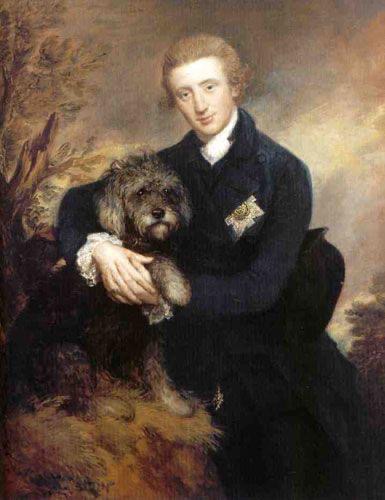
Henry Scott, 3rd duke of Buccleuch, by Thomas Gainsborough, 1770 or 1771, Bowhill House
Charles Townshend, the chancellor responsible for the taxes that ultimately caused the American Revolution, was so impressed by Smith’s Moral Sentiments that he invited the author to become tutor to his stepson, Henry Scott, the 17-year-old duke of Buccleuch. The duke was portrayed by Thomas Gainsborough in 1770 or 1771, wearing the insignia of the Order of the Garter and hugging a Dandie Dinmont terrier. Smith did not morally approve of the Grand Tour, but an annual income of £300 plus expenses, roughly twice his pay as a professor, and a lifetime pension of £300 a year thereafter, was persuasive. Tutor and pupil set out for Toulouse via Paris on 13 February 1764, spending close on three years together and getting on remarkably well.
Eighteen months in Toulouse offered little in the way of variety, but Smith used his time there to start working on Wealth of Nations. In a livelier two month visit to Geneva, he met Voltaire. A ten month stay in Paris then enabled him to meet more of “the French literary figures he had read and lectured on with warm appreciation” (ODNB). Helped with introductions by David Hume, also in Paris, he frequented the literary salons of the duchesse d’Enville and Julie de L’Espinasse; the German-French encylopedist Baron d’Holbach welcomed him; and he was no less feted at the house of the tax farmer and philosophe Claude-Adrien Helvétius. André Morellet, his future translator, and Anne-Robert-Jacques Turgot, Controller-General of Finance from 1774 to 1776, were among others he met. François Quesnay, leader of the physiocrats, probably impressed him the most, and would have been the dedicatee of his treatise had his death not occurred first.
Moral Sentiments, the talk of Paris, drew much admiration from women. The former actress and novelist Marie-Jeanne Riccoboni declared Smith to be as ugly as the devil with his harsh voice and protruding teeth. Yet she had plenty of time for his sentimental philosophy, remarking in a letter to David Garrick, “J’aime Mr Smith, je l’aime beaucoup” (quoted by James Buchan, The Authentic Adam Smith, 2006, p.79). The fascinating comtesse de Boufflers, patroness of Rousseau, was thanked by David Hume for taking “my friend Smith under your protection” (HL ii.63). By no means intimidated by Parisian society, he attended operas, plays and concerts, wearing an impressive array of black, grey and red silk suits.
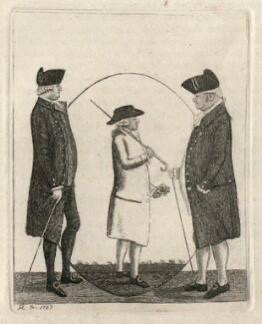
Alexander Gordon, Lord Rockville; Adam Smith; George Brown, by John Kay, 1787, etching
Unfortunately, the duke fell ill as did his younger brother, Hew, who had joined the party at Toulouse. Though the former recovered, Quesnay’s efforts as royal physician could not save Hew. Their stay in Paris cut short, Smith and the duke accompanied Hew’s body back to Dover, arriving 1 November 1766. Only too glad to be back among old friends, Smith never crossed the English channel again. Wealth of Nations made trenchant criticism of the ancient regime’s reliance on fiscal anomalies, manipulation of the coinage, arbitrary taxation, soaring public debt, and depressed agriculture.
Having spent six months in London, supervising publication of the third edition of Moral Sentiments and attending the duke of Buccleuch’s wedding, Smith returned to live with his mother in Kirkcaldy. Six years were spent reading and writing in this retirement. He wrote to David Hume saying that “My amusements are long, solitary walks by the sea side” and expressed himself “extremely happy … I never was, perhaps, more so in all my life” (quoted by Buchan, p. 84). As opposed to reaching completion, his magnum opus simply grew larger.
Having chosen not to become Hume’s neighbour in Edinburgh, Smith was at length persuaded to travel to London in 1772. The offer of another tutoring post, this time to the young duke of Hamilton, came to nothing. Nonetheless, Smith stayed on, attending political debates in parliament as the conflict between Britain and her American colonies intensified. He became a member of the Royal Society in May 1773. The Boston Tea Party on 16 December that year was the direct consequence of Townshend’s taxation measures. On 9 May 1775 Smith assured Hume, in Edinburgh, that his book was about to go to press. In February 1776 a letter of Hume’s expressed the concern that if Smith was waiting for the fate of America to be decided, he might have to wait forever.
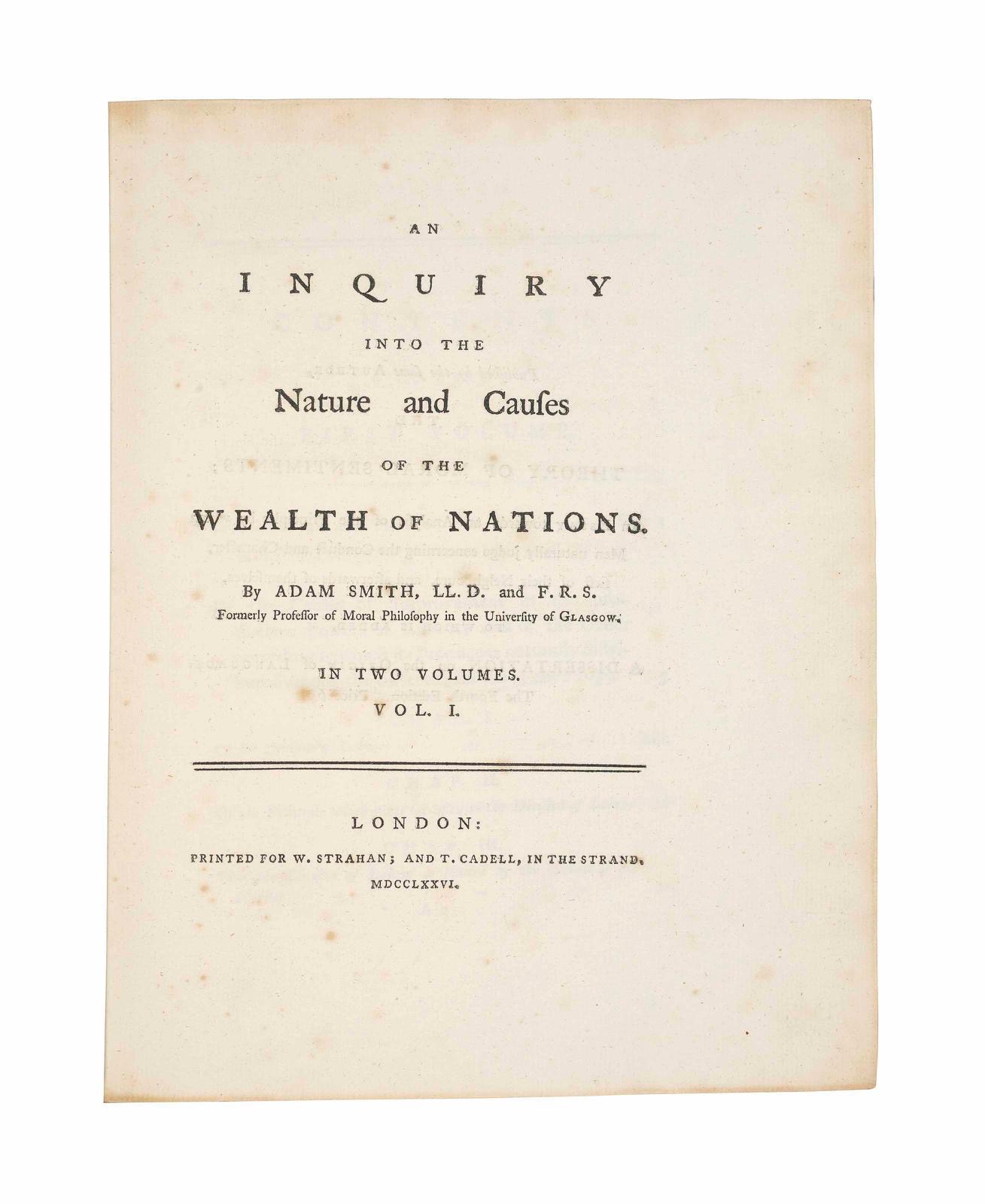
Title-page to the first edition of Smith’s Wealth of Nations
Smith’s book finally appeared on 3 March 1776. Entitled An Inquiry into the Nature and Causes of the Wealth of Nations, it carried the imprint of W. Strahan and T. Cadell in the Strand; some copies have the added imprint of W. Creech at Edinburgh. In the event, publication occurred only four months before the 4 July signing of the American Declaration of Independence. The author showed himself to be quite radical in his leanings, particularly in regard to the American colonists whose ill treatment by the government he discusses in book IV. Despite fully agreeing with Hume that independence was a natural outcome for growing colonies, he also put forward the idea of a closer union or federation with Britain, with power likely to gravitate to the west.
The two quarto volumes contained over 1000 pages, arranged in five books, and representing at least 12 years work. Issued in either blue-grey or marbled boards, the work cost £1 16 shillings — then enough money to employ a skilled tradesman for 15 days. The print run is put at 500 copies.
Only a week earlier Strahan and Cadell had brought out volume I of Gibbon’s Decline and Fall of the Roman Empire, also in quarto. Writing to David Hume on 12 April, Strahan compared the two works; Gibbon’s he described as “more popular”; Smith’s book he judged to have a sale which, “tho’ not near so rapid, has been much more than I could have expected from a work, that requires much thought and reflexion (qualities that do not abound among modern readers) ….” (NLS Hume MSS vii.67, old no).
Smith’s arguments in Wealth of Nations are well summarised in Ian Simpson Ross’s Life of Adam Smith (1995, pp. 270-288). Whereas Moral Sentiments had dealt with various forms of motivation, his later book dealt with economic motivation only, and its effect on the collective wealth of nations. Smith argues that material progress stems from the individual’s desire for self-improvement; a nation’s riches do not consist of bullion or treasure, but in the acquired skills or specialisations of its labour force, supported by capital.
Book I, on “the Causes of Improvement in the Productive Powers of Labour”, starts with a brilliant though, in the light of subsequent history, flawed appraisal of the the division of labour, which he believes can improve the individual labourer’s circumstances, while creating greater wealth for the whole of society. The division of the 18 operations used in making a pin, borrowed from the French Encylopédie of 1755, make its advantages demonstrable.
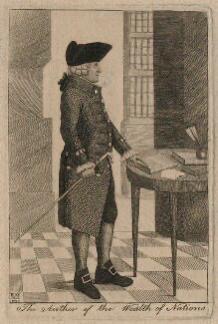
Adam Smith by John Kay, etching, 1790
Book I then proceeds with a discussion of the origin and use of money, followed by an analysis of commodity prices in terms of labour cost and in terms of money. Careful distinctions are also drawn between the component parts of commodity prices, and the natural and market price of commodities. A forensic examination of wages and profits comes next, and then a final discourse on the rent of land, with a long digression on silver. Since the accumulation of profit allows for rising wages and the enhancement of culture, the profit motive is not seen as harmful. The individual’s liberty of action guarantees the welfare of society.
Whereas the 11 chapters in book I come under the heading of “Labour”, the 5 chapters in book II are on “the nature, accumulation, and employment of stock” — stock (i.e. “savings and investments”) being a second growth factor after the division of labour. There is a continued look at money as “a particular Branch of the general Stock of the Society”. Lines are drawn between productive and unproductive labour, and fixed and circulating capitals.
The remaining books, III-V, are more historical in nature, concentrating on what legislators have done and what they ought to do to achieve economic growth. Book III traces “the different progress of Opulence in different nations”. The time period starts as far back as the fall of Rome and the development of medieval towns, when capital first supported agriculture, to its later extension to manufactures, and finally foreign trade with its positive socio-economic effects.
Book IV, “Of Systems of Political Economy”, is a highly readable, deeply critical account of what Smith pejoratively termed the mercantile system giving the European nations monopolistic control over their colonies. England is only the best of a bad bunch, “somewhat less illiberal and oppressive than any of the rest” (IV.vii.pt.2).
Smith’s belief in the efficacy of free trade, with its stimulus to the industry of the European nations, cannot be over-stated. Hence he calls “the discovery of America, and that of a passage to the East Indies by the Cape of Good Hope … the two greatest and most important events in the history of mankind” (IV.viii.pt.3). With these words, he is surely anticipating a harmonious global economy.
The final chapter of book IV, “Of the Agricultural Systems, or of those Systems of Political Economy which represent the Produce of Land as either the sole or the principal Source of the Revenue and Wealth of every County”, was a response to Quesnay and the French physiocrats; sympathetic as he was to their ideas, Smith was unable to accept their portrayal of manufacturing and trading as unproductive.
In Book V, “Of the Revenue of the Sovereign or Commonwealth”, the involvement of government is accepted as necessary in defence, justice, policing, transport facilities, education, and taxation. A policy of non interference is urged in matters of trade. The British government’s readiness to incur public debt in order to prosecute wars over the colonies meets with a severe reproof.
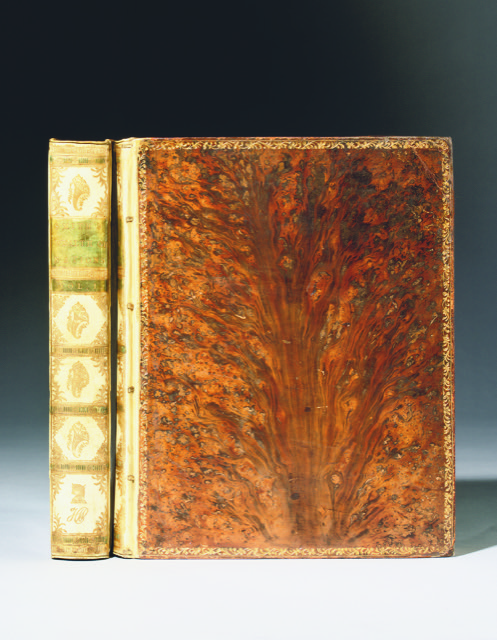
Henry Wickham’s copy of Wealth of Nations (2 vols) bound by Edwards of Halifax. Courtesy of Christie’s
Four more editions of Wealth of Nations came out before the author’s death in 1790. The third edition of 1784 was the first in octavo. The Additions and Corrections to the first and second editions of Dr. Adam Smith’s … Wealth of Nations, issued at the same time, was available in either quarto or octavo size. While not an integral part of the first edition, it is sometimes bound at the end of volume II or may, alternatively, form a slim volume III.
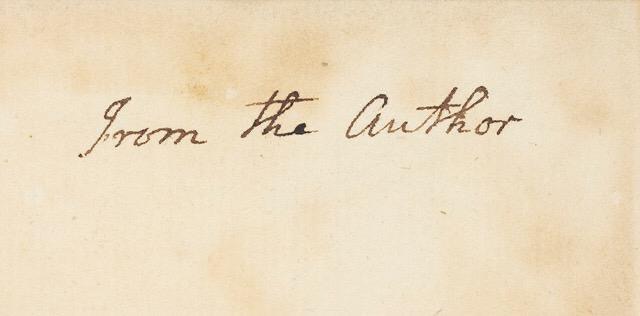
Secretarial presentation inscription on Henry Herbert, Lord Porchester’s copy of Wealth of Nations. Courtesy of Christie’s
A copy of the first edition, without serious defects, might have been bought for about £12,000 in 1990. Sotheby’s sold a copy in a restored calf binding for £11,000 hammer which became £12,100 with premium, on 19 July 1990. While its steady advance in value over the next 30 years has to be seen as extraordinary, it is a sobering thought that the purchasing power of the pound has halved since 1990.
Ten years on and the William Foyle copy came up for sale. Although the binding — described as “near contemporary sheep” — was not particularly impressive, the Foyle copy included the Additions and Corrections. Astonishment overtook the packed Great Room when Christies sold it for as much as £34,000 hammer on 12 July 2000. This was no lucky chance; the price signalled a quantum leap forward in value.
If it is correct to speak of trophy books, Wealth of Nations became one in the new millennium. From 2000 onwards its value soared. However, condition and copy status will always lead to variations in price as will the supply of copies. Of two copies sold in New York in December 2004, one at Sotheby’s made $80,000 (£41,510) hammer; the other at Christie’s went for $40,000 hammer, exactly half the amount. The latter was simply an inferior copy.
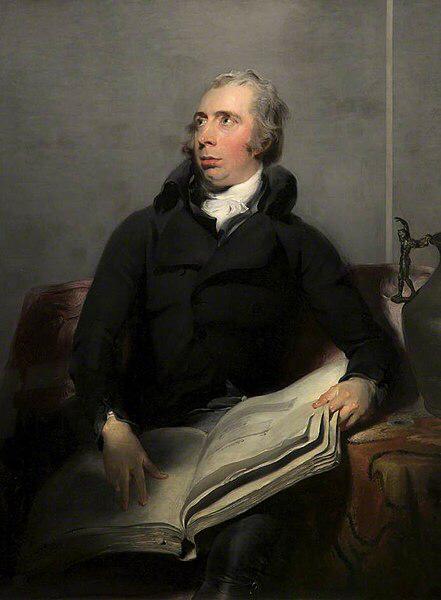
Richard Payne Knight by Sir Thomas Lawrence, 1794, Whitworth Art Gallery
The following year, 2005, the “remarkably clean, fine and totally unsophisticated” Irwin Silver copy” in contemporary calf gilt reached $120,000 (£62,967) hammer, with premium $144,000 (£75,560), at Sotheby’s New York. The auction gavel then started to spark at Christie’s. In 2007 £85,000 was paid for the Henry Wickham copy, exquisitely bound by Edwards of Halifax in tree calf with painted vellum spines. The Foljambe copy made £130,000 in 2010; the Londonderry copy £120,000 in 2013; £150,000 was given in 2014 for a presentation copy in a secretarial hand to Smith’s former pupil, Henry Herbert, Lord Porchester.
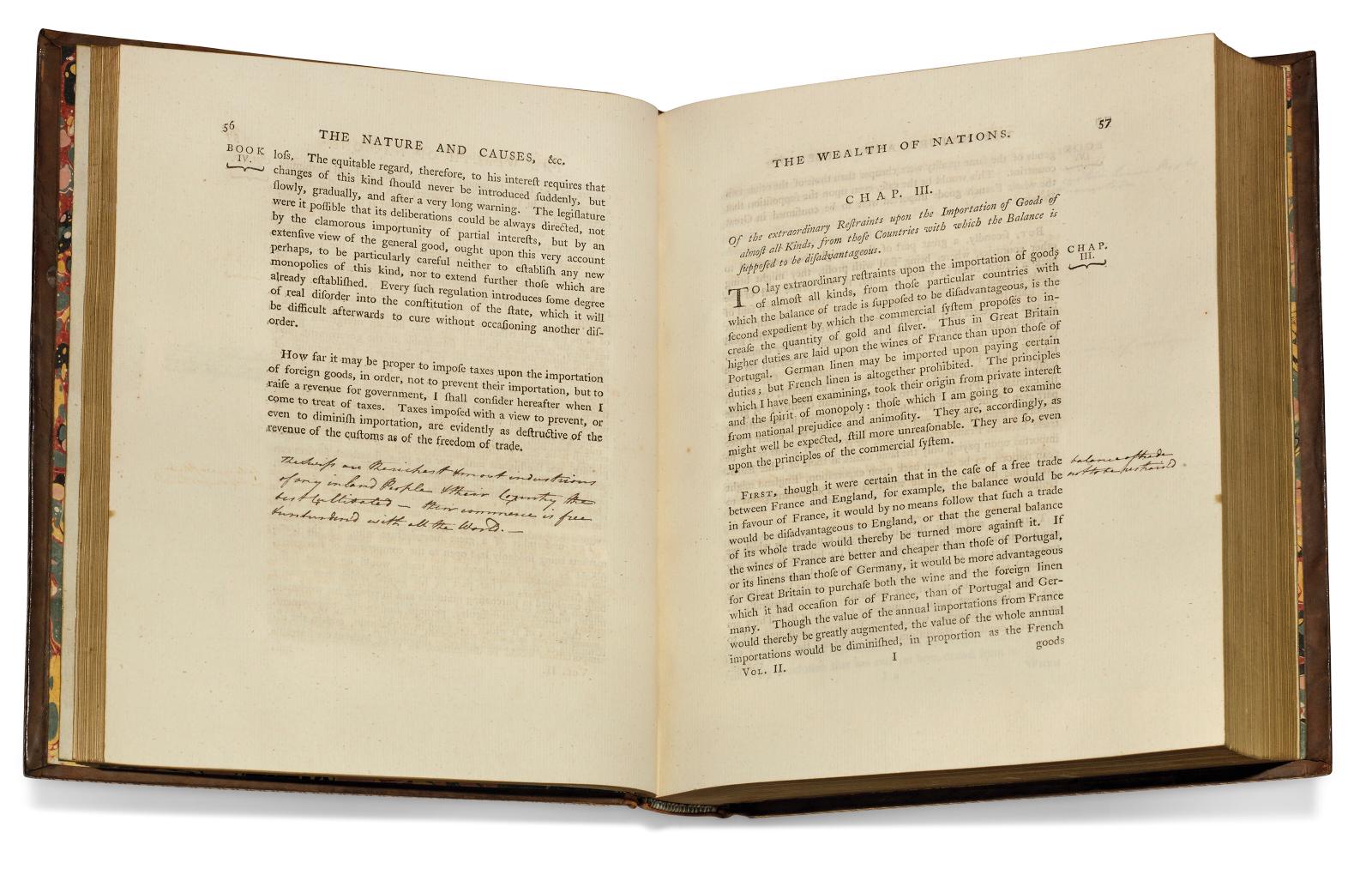
Bronze statue of Adam Smith by Alexander Stoddart, 2008, on the Royal Mile, Edinburgh
Last year, when as many as four copies came up for auction, results were consistently good if less sensational. At Christie’s New York bidding on one copy closed at $80,000 (£62,373); another copy made $90,000 (£69,765) in Chicago; and one at Sotheby’s London was taken to £70,000, virtually the same figure. Richard Payne Knight, the art connoisseur known for his interest in picturesque beauty and ancient phallic imagery, was the owner of the copy which came up at Christie’s on 11 December. With his annotations in volume II, the Payne Knight copy sold for a well deserved £90,000; with premium £112,500.
The value of an uncut copy in original boards has yet to be tested. The copy of the first edition which has made the most money to date is, appropriately enough, Smith’s own. One of two copies listed in his manuscript library catalogue of 1781, this has a binding of contemporary tree calf, restored by J. Macdonald. Somewhat disappointingly, there are no manuscript notes by the author and but one sign of his ownership, a small letterpress book label with his name on it. He was modest to the last.
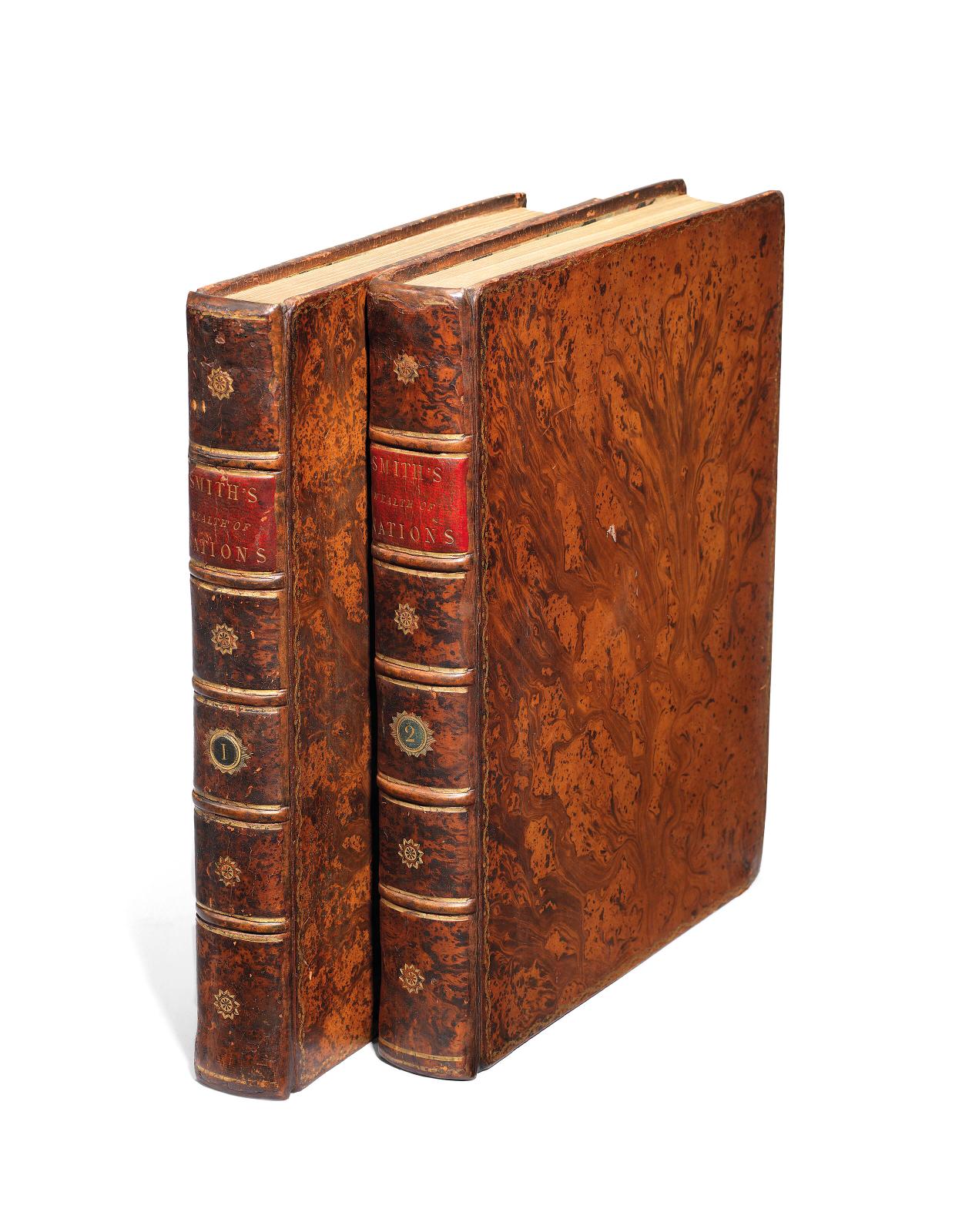
The contemporary tree calf binding of the author’s copy. Courtesy of Christie’s
Yet this was the author’s copy of a work which has remained the foundation of political economy to this day. Homer B. Vanderblue, a professor at Harvard Business School and celebrated Smith collector, had acquired it sometime after 1939. Though the present whereabouts of Smith’s other copy is undetermined, it is known to have made £420 at auction in 1959. In contrast the Smith-Vanderblue copy, sold by Christie’s as lot 220 on 12 December, 2018, brought a hammer price of £750,000; with premium added this became £908,750; a breathtaking amount worthy of the great philosopher of money.
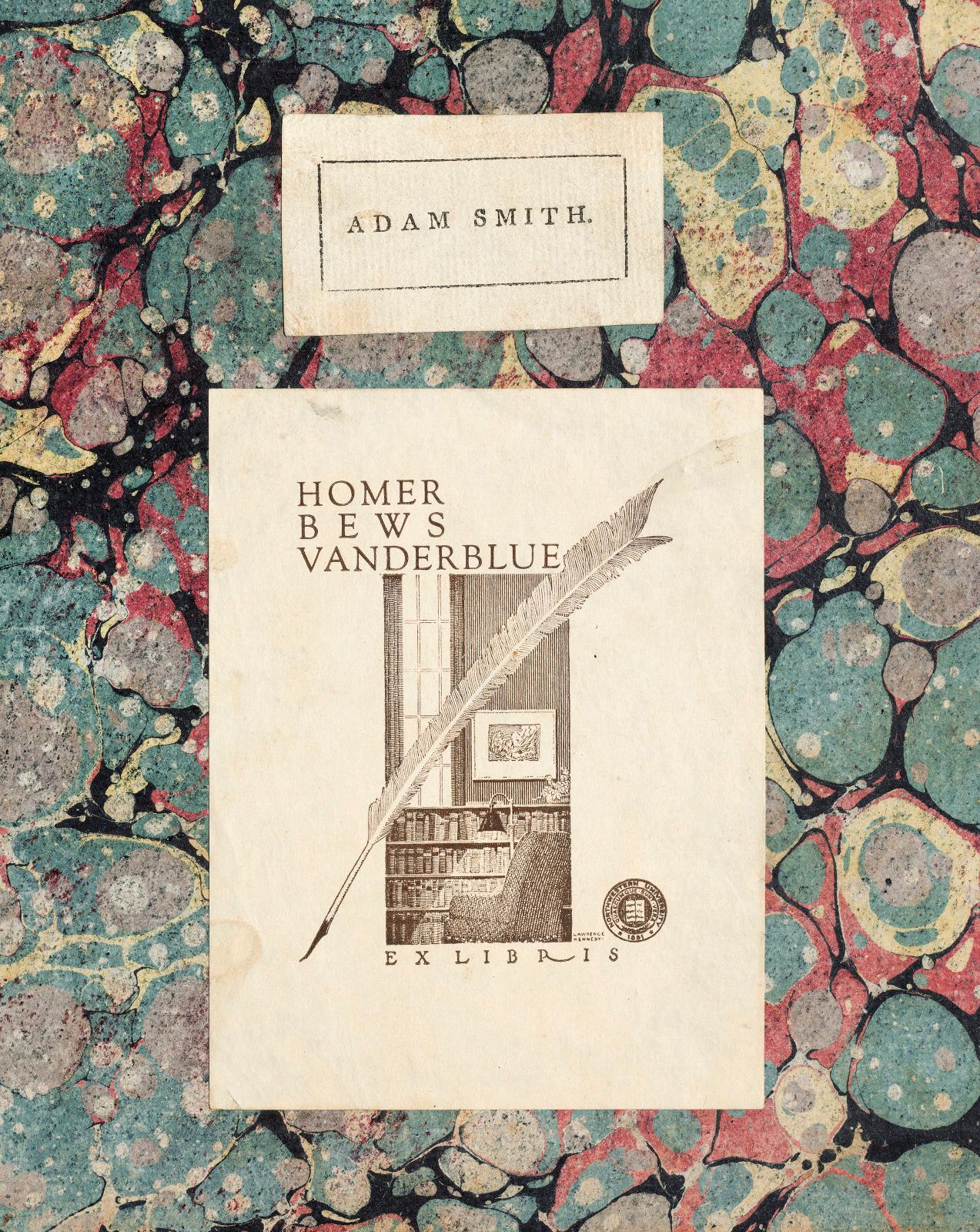
Ownership labels in Adam Smith’s own copy of Wealth of Nations. Courtesy of Christie’s






